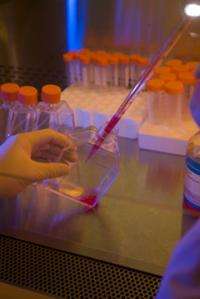Researchers use computer model to probe mysteries of human immune system

A new computational model developed by a team of Virginia Tech researchers and published in PLoS Computational Biology provides a framework to better understand responses of macrophage cells of the human immune system.
As the security guards of the body, macrophage cells must identify and respond to a pathogen attack while causing as little damage as possible to host cells. An excessive or prolonged immune response could lead to serious acute and chronic inflammatory diseases such as multiple sclerosis, type II diabetes, and even sepsis. Therefore, studying how the macrophage immune response could be altered or reprogrammed by sequential pathogen attacks, known as priming and tolerance, is of vital importance to the field.
Jianhua Xing, assistant professor of biological sciences, collaborated with experimental immunologist Liwu Li, and computational biologist John Tyson, both professors of biological sciences, to develop the model with Yan Fu of Beijing, China, a student in the interdisciplinary doctoral program in genetics, bioinformatics, and computation biology. Trevor Glaros of Greencastle, Pa., a student in the biological sciences doctoral program in the College of Science, performed the experimental analyses regarding the endotoxin priming and tolerance in primary murine macrophages. All are affiliated with the Fralin Life Science Institute at Virginia Tech.
"The concept of priming refers to the fact that if macrophages are exposed to a small dose of bacterial endotoxins, they are primed to respond strongly to a second exposure to a large dose of endotoxin. The concept of tolerance refers to the fact that if macrophages are exposed to a large dose of bacterial endotoxins initially, they are temporarily resistant to endotoxin challenges afterwards," Xing said.
The Virginia Tech team used the Metropolis algorithm, a computer simulation technique widely used in physics and chemistry, to enumerate possible molecular mechanisms giving rise to priming and tolerance.
The results of the model, supported by numerous experimental observations, may guide future experimental studies to identify molecules contributing to macrophage priming and tolerance.
"Because macrophage responses are highly diverse, additional modeling studies and experimental tests will be needed to understand better how well-mannered macrophages protect us from infection and how unruly macrophages damage our health," Tyson said. "We are convinced that mathematical modeling will provide novel insights into macrophage behavior, with significant medical implications."
More information: Fu Y, Glaros T, Zhu M, Wang P, Wu Z, et al. (2012) Network Topologies and Dynamics Leading to Endotoxin Tolerance and Priming in Innate Immune Cells. PLoS Comput Biol 8(5): e1002526. doi:10.1371/journal.pcbi.1002526
Journal information: PLoS Computational Biology
Provided by Virginia Tech

















